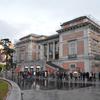More about The Monkey Sculptor

Sr. Contributor
The Monkey Sculptor, on display at the Prado National Museum, belongs to a genre called singerie, from the French for "monkey tricks,” or “monkey games."
There are certain people who may look at a piece of art and say something along the lines of, “If you put a paintbrush in a monkey’s hand he could probably do better.” In the case of The Monkey Sculptor, however, one would need to put a hammer and chisel in the hands of said monkey. In these paintings, monkeys usually take on a human persona, sometimes (but not always) wearing human clothes and hats. The monkeys have been depicted painting, sculpting, drinking in taverns, playing backgammon, attending school, eating and drinking from plates and glasses, smoking, as players in a theater, and more. For some reason, at times the monkeys interact with cats; there are monkey musicians playing instruments while the cats “sing,” a monkey physician examining a cat, a monkey painter with a cat as his model, monkey soldiers with a cat prisoner (unknown what the cat did wrong) and so on.
Art that has singerie as a theme became popular in the 16th century, but its roots go back much further; monkeys have been used as allegorical figures, as decorative additions in illuminated manuscripts, and in a variety of ancient art from Egyptian tombs to friezes and sculpture in the Roman Empire. The singerie monkeys were often used to mock human activities, contemporary social mores, or even a specific person or persons. Pieter van der Borcht (the Elder), a Flemish painter and engraver, can probably be credited with introducing singerie to a larger audience; in the 1560s-1570s he produced a series of 18 prints with monkeys, including monkeys doing laundry and running a barbershop.
The amusing paintings became a trendy sight during the golden age of the kunstkamer, which translates as “art room”, but was more commonly known as a “cabinet of curiosities.” Apparently, this type of painting was just the ticket to round out a well-furnished kunstkamer, which usually contained oddities from foreign lands, animal parts (maybe a narwhal tusk or two?), and of course, works of art; a painting with monkeys acting like humans would be perfect!
David Teniers the Younger, was one of the more prolific painters of his era, and he created several examples of this genre of art; the “companion piece” to The Monkey Sculptor, is The Monkey Painter, also at the Prado. In The Monkey Sculptor, one of the interpretations is that the work is being critical of artists who merely copy another’s work, as in “monkey see, monkey do.” Then again, it might just be a painting to amuse the viewer with no deeper meaning attached.
Sources
- Davidson, Jane P. David Teniers the Younger. Boulder, CO: Westview Press, 1979.
- Lee, Alexander. 2020. “Monkeys Natural Histories.” History Today 10 (2): 84–88. http://0-search.ebscohost.com.pacificatclassic.pacific.edu/login.aspx?d….
- Levy, Ellen K. “Contemporary Art and the Genetic Code: New Models and Methods of Representation.” Art Journal 55, no. 1 (1996): 20. https://doi.org/10.2307/777802.
- Wheelock, Arthur K. Flemish Paintings of the Seventeenth Century. Washington, D.C.: National Gallery of Art, 2005.
- “The Singerie: Monkeys Acting as Humans in Art.” The Public Domain Review. Accessed February 12, 2020. https://publicdomainreview.org/collection/the-singerie-monkeys-acting-a….
- “Monkeys.” British Museum. Accessed February 19, 2020. https://research.britishmuseum.org/research/collection_online/collectio….











